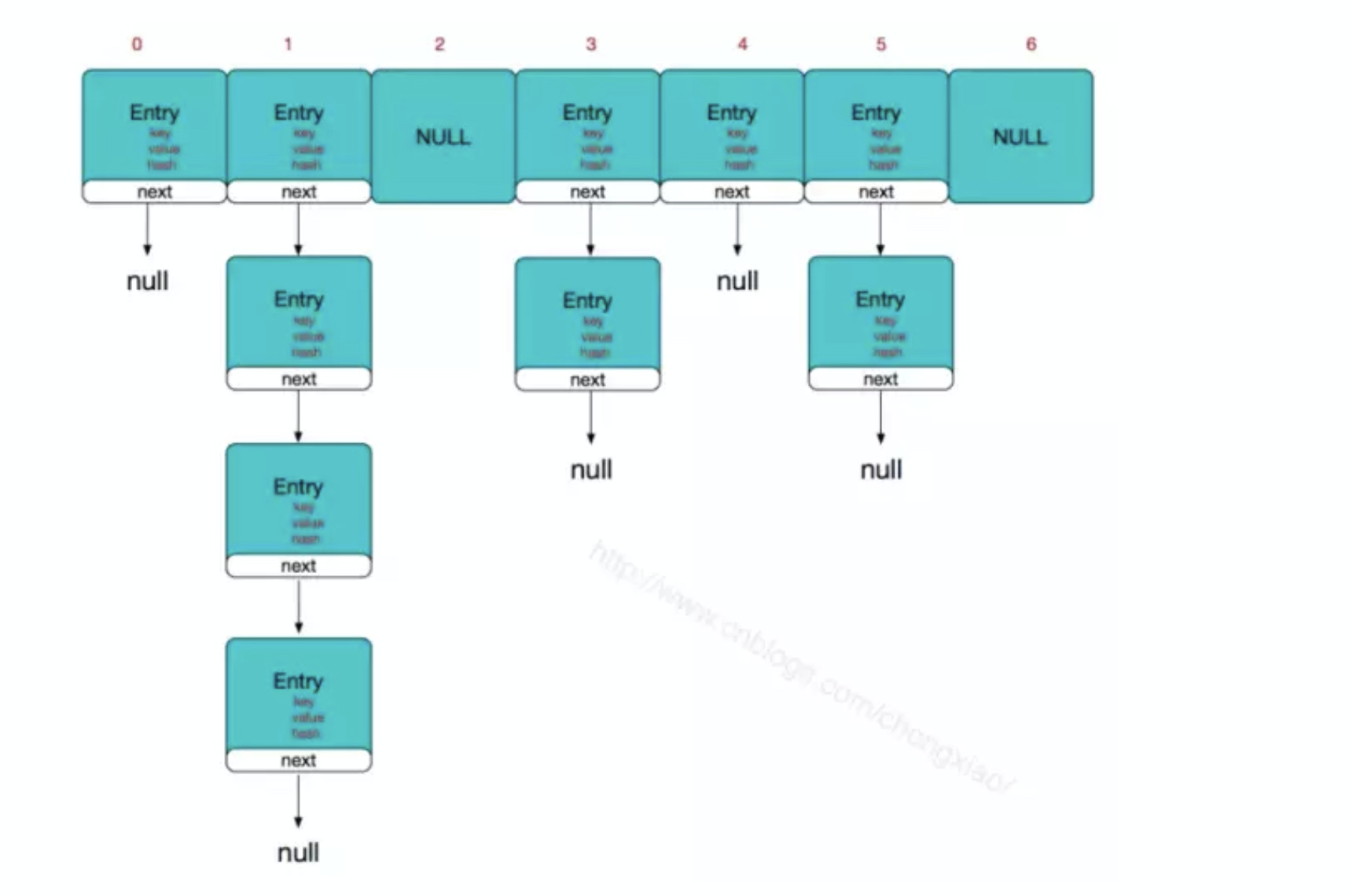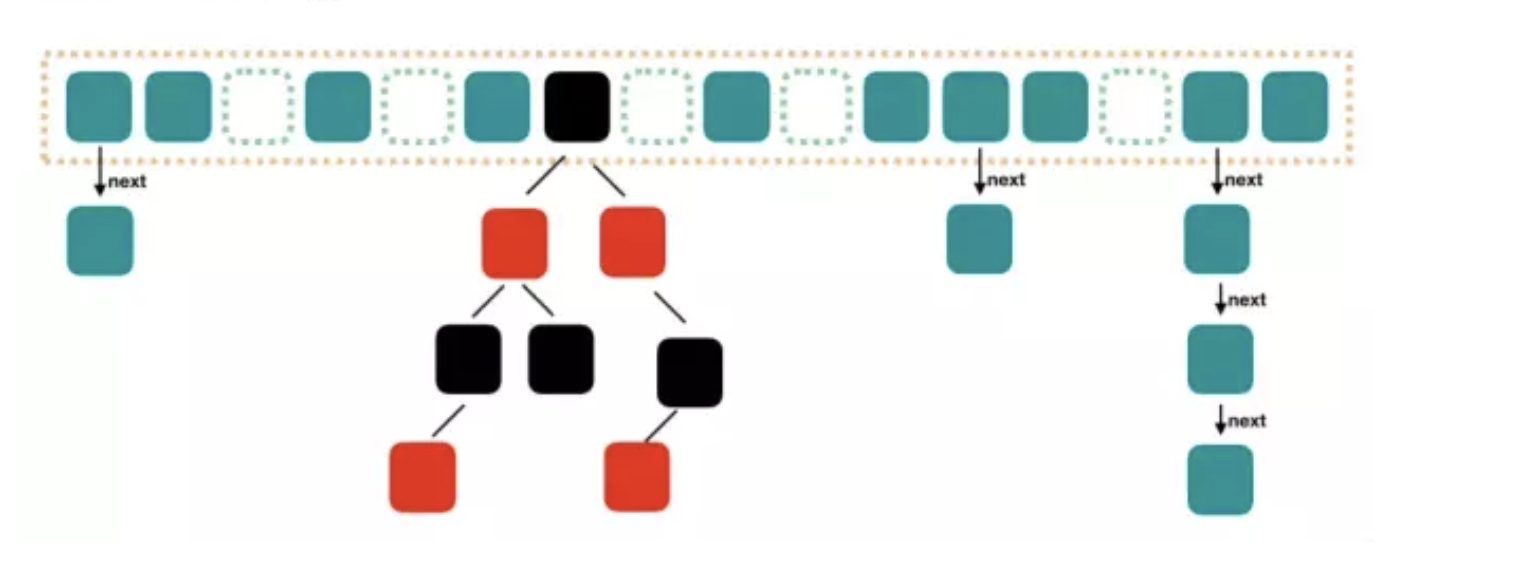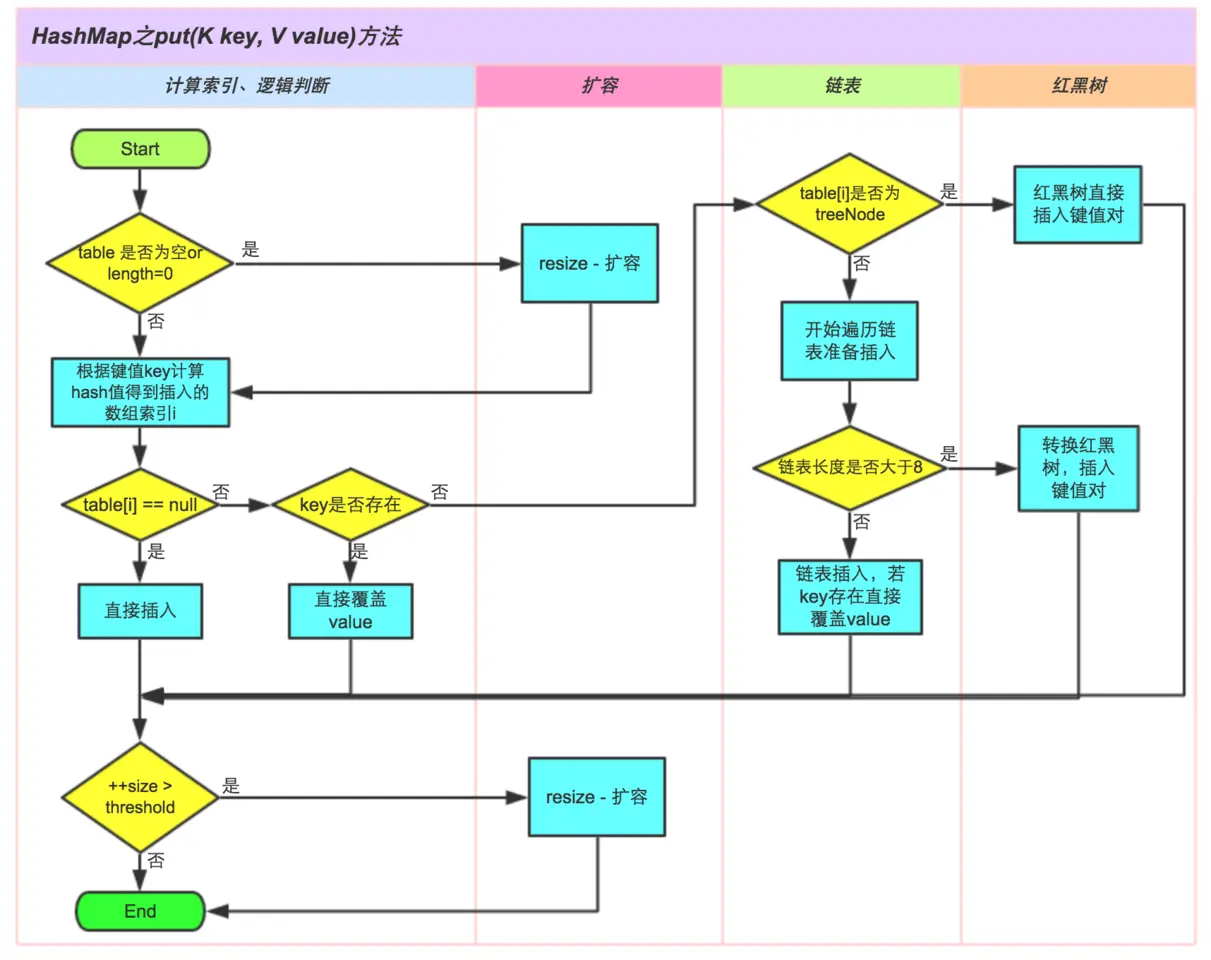HashMap
一、基础概念
在JDK8及以后的版本中,HashMap引入了红黑树结构,其底层的数据结构变成了由数组+链表变成数组+链表和数组+红黑树
HashMap整体结构:

JDK1.8 后 HashMap的红黑树结构

红黑树的转换
参考: https://juejin.im/entry/5839ad0661ff4b007ec7cc7a
几个参数:
1
2
3
4
5
6
7
|
static final int TREEIFY_THRESHOLD = 8;
static final int UNTREEIFY_THRESHOLD = 6;
static final int MIN_TREEIFY_CAPACITY = 64;
|
添加元素时,默认如果桶中链表个数超过7,链表会尝试转换成红黑树:
1
2
3
4
5
6
7
8
9
|
if (tab == null || (n = tab.length) < MIN_TREEIFY_CAPACITY) {
resize();
}
if (binCount >= TREEIFY_THRESHOLD - 1) {
treeifyBin(tab, hash);
}
|
当调用risize方法()扩容时,如果当前桶中元素结构是红黑树,并且元素个数小于链表还原阈值 UNTREEIFY_THRESHOLD (默认为 6),就会调用split()方法把桶中的树形结构缩小或者直接还原(切分)为链表结构:
1
2
3
| if (lc <= UNTREEIFY_THRESHOLD) {
tab[index] = loHead.untreeify(map);
}
|
二、HashMap的默认参数理解
为什么HashMap的Entry数组长度默认为16呢?为什么数组长度一定要是2的n次幂呢?
首先看HashMap计算hashcode的方法获取存储的位置方法:
1
2
3
| static int indexFor(int h, int length) {
return h & (length-1);
}
|
长度16或者其他2的幂,length - 1的值是所有二进制位全为1,这种情况下,index的结果等同于hashcode后几位的值,只要输入的hashcode本身分布均匀,hash算法的结果就是均匀的
所以:HashMap的默认长度为16和规定数组长度为2的幂,是为了降低hash碰撞的几率
HashMap扩容限制的负载因子为什么是0.75?
HashMap中扩容方式是通过新建一个长度为之前数组2倍的新的数组,然后将当前的Entry数组中的元素全部传输过去,扩容后的新数组长度为之前的2倍,所以扩容相对来说是个耗资源的操作
扩容的触发条件是: 临界值 = 数组默认的长度 x 负载因子
- 如果负载因子为0.5甚至更低的可能的话,最后得到的临时临界值明显会很小,这样的情况就会造成分配的内存的浪费,存在多余的没用的内存空间,也不满足了哈希表均匀分布的情况
- 如果负载因子达到了1的情况,也就是Entry数组存满了才发生扩容,这样会出现大量的哈希冲突的情况,出现链表过长,影响get查询数据的效率
- 因此选择了0.5~1的折中数也就是0.75,均衡解决了上面出现的情况
三、HashMap的基本操作
get 操作
1
2
3
4
5
6
7
8
9
10
11
12
13
14
15
16
17
18
19
20
21
22
23
24
25
26
27
28
29
30
31
32
33
34
35
36
37
38
39
40
41
42
43
44
|
public V get(Object key) {
Node<K,V> e;
return (e = getNode(hash(key), key)) == null ? null : e.value;
}
final Node<K,V> getNode(int hash, Object key) {
Node<K,V>[] tab; Node<K,V> first, e; int n; K k;
if ((tab = table) != null && (n = tab.length) > 0 &&
(first = tab[(n - 1) & hash]) != null) {
if (first.hash == hash &&
((k = first.key) == key || (key != null && key.equals(k))))
return first;
if ((e = first.next) != null) {
if (first instanceof TreeNode)
return ((TreeNode<K,V>)first).getTreeNode(hash, key);
do {
if (e.hash == hash &&
((k = e.key) == key || (key != null && key.equals(k))))
return e;
} while ((e = e.next) != null);
}
}
return null;
}
|
put 操作

1
2
3
4
5
6
7
8
9
10
11
12
13
14
15
16
17
18
19
20
21
22
23
24
25
26
27
28
29
30
31
32
33
34
35
36
37
38
39
40
41
42
43
44
45
46
47
48
49
50
51
52
53
54
55
56
57
58
59
60
61
62
63
64
65
66
67
68
69
70
71
72
73
74
75
76
| public V put(K key, V value) {
return putVal(hash(key), key, value, false, true);
}
final V putVal(int hash, K key, V value, boolean onlyIfAbsent,
boolean evict) {
Node<K,V>[] tab; Node<K,V> p; int n, i;
if ((tab = table) == null || (n = tab.length) == 0)
n = (tab = resize()).length;
if ((p = tab[i = (n - 1) & hash]) == null)
tab[i] = newNode(hash, key, value, null);
else {
Node<K,V> e; K k;
if (p.hash == hash &&
((k = p.key) == key || (key != null && key.equals(k))))
e = p;
else if (p instanceof TreeNode)
e = ((TreeNode<K,V>)p).putTreeVal(this, tab, hash, key, value);
else {
for (int binCount = 0; ; ++binCount) {
if ((e = p.next) == null) {
p.next = newNode(hash, key, value, null);
if (binCount >= TREEIFY_THRESHOLD - 1)
treeifyBin(tab, hash);
break;
}
if (e.hash == hash &&
((k = e.key) == key || (key != null && key.equals(k))))
break;
p = e;
}
}
if (e != null) {
V oldValue = e.value;
if (!onlyIfAbsent || oldValue == null)
e.value = value;
afterNodeAccess(e);
return oldValue;
}
}
++modCount;
if (++size > threshold)
resize();
afterNodeInsertion(evict);
return null;
}
|
扩容操作
1
2
3
4
5
6
7
8
9
10
11
12
13
14
15
16
17
18
19
20
21
22
23
24
25
26
27
28
29
30
31
32
33
34
35
36
37
38
39
40
41
42
43
44
45
46
47
48
49
50
51
52
53
54
55
56
57
58
59
60
61
62
63
64
65
66
67
68
69
70
71
72
73
74
75
76
77
78
79
80
81
82
83
84
85
86
87
88
89
90
91
92
93
94
95
96
97
98
99
100
101
102
103
104
|
final Node<K,V>[] resize() {
Node<K,V>[] oldTab = table;
int oldCap = (oldTab == null) ? 0 : oldTab.length;
int oldThr = threshold;
int newCap, newThr = 0;
if (oldCap > 0) {
if (oldCap >= MAXIMUM_CAPACITY) {
threshold = Integer.MAX_VALUE;
return oldTab;
}
else if ((newCap = oldCap << 1) < MAXIMUM_CAPACITY &&
oldCap >= DEFAULT_INITIAL_CAPACITY)
newThr = oldThr << 1;
}
else if (oldThr > 0)
newCap = oldThr;
else {
newCap = DEFAULT_INITIAL_CAPACITY;
newThr = (int)(DEFAULT_LOAD_FACTOR * DEFAULT_INITIAL_CAPACITY);
}
if (newThr == 0) {
float ft = (float)newCap * loadFactor;
newThr = (newCap < MAXIMUM_CAPACITY && ft < (float)MAXIMUM_CAPACITY ?
(int)ft : Integer.MAX_VALUE);
}
threshold = newThr;
@SuppressWarnings({"rawtypes","unchecked"})
Node<K,V>[] newTab = (Node<K,V>[])new Node[newCap];
table = newTab;
if (oldTab != null) {
for (int j = 0; j < oldCap; ++j) {
Node<K,V> e;
if ((e = oldTab[j]) != null) {
oldTab[j] = null;
if (e.next == null)
newTab[e.hash & (newCap - 1)] = e;
else if (e instanceof TreeNode)
((TreeNode<K,V>)e).split(this, newTab, j, oldCap);
else {
Node<K,V> loHead = null, loTail = null;
Node<K,V> hiHead = null, hiTail = null;
Node<K,V> next;
do {
next = e.next;
if ((e.hash & oldCap) == 0) {
if (loTail == null)
loHead = e;
else
loTail.next = e;
loTail = e;
}
else {
if (hiTail == null)
hiHead = e;
else
hiTail.next = e;
hiTail = e;
}
} while ((e = next) != null);
if (loTail != null) {
loTail.next = null;
newTab[j] = loHead;
}
if (hiTail != null) {
hiTail.next = null;
newTab[j + oldCap] = hiHead;
}
}
}
}
}
return newTab;
}
|
四、Java中HashMap的key值要是为类对象则该类需要满足什么条件
一般使用String、Integer这样的包装类作为 key 键, 原因是:
- 这种包装类型为 final 类型, 具有不可更改性, 因此保证了 hash 值的不可更改性和计算准确性
- 内部重写了 equals(), hashcode() 方法
因此若 HashMap 中的 key 为类对象的话,需要重写 hashcode 和 equals() 方法
五、HashMap是怎么解决哈希冲突的?
解决哈希冲突的方法
解决哈希冲突的常用方法分析
开放定址法
从发生冲突的那个单元起,按照一定的次序,从哈希表中找到一个空闲的单元。然后把发生冲突的元素存入到该单元的一种方法,需要的表长度要大于等于所需要存放的元素
包括以下几种方法
- 线性探查法
从发生冲突的单元起,依次判断下一个单元是否为空,当达到最后一个单元时,再从表首依次判断。直到碰到空闲的单元或者探查完全部单元为止
- 平方探查法
发生冲突时,用发生冲突的单元d[i], 加上 1²、 2²等。即d[i] + 1²,d[i] + 2², d[i] + 3²…直到找到空闲单元
- 双散列函数探查法
链地址法(拉链法)
链接地址法的思路是将哈希值相同的元素构成一个同义词的单链表,并将单链表的头指针存放在哈希表的第i个单元中,查找、插入和删除主要在同义词链表中进行
再哈希法
就是同时构造多个不同的哈希函数:
Hi = RHi(key) i= 1,2,3 … k;
当H1 = RH1(key) 发生冲突时,再用H2 = RH2(key) 进行计算,直到冲突不再产生,这种方法不易产生聚集,但是增加了计算时间
六、HashMap在JDK1.7和JDK1.8中有哪些不同
1.8 加入了 红黑树,遍历查询时间复杂度由原来链表的 O(n) 变为 O(logn)
在插入数据的时候, 1.7基于头插法,这会产生逆序且环形链表死循环问题, 而1.8基于尾插法避免了这个问题,详见: jdk1.7HashMap链表成环的原因和jdk1.8的解决方案
扩容后数据存储位置的计算方式不一样
JDK 1.7 使用hashCode() + 4次位运算 + 5次异或运算(9次扰动)
1
2
3
4
5
| static final int hash(int h) {
h ^= k.hashCode();
h ^= (h >>> 20) ^ (h >>> 12);
return h ^ (h >>> 7) ^ (h >>> 4);
}
|
JDK 1.8 简化了扰动函数,只做了2次扰动 = 1次位运算 + 1次异或运算
1
2
3
4
5
6
7
| static final int hash(Object key) {
int h;
return (key == null) ? 0 : (h = key.hashCode()) ^ (h >>> 16);
}
|
七、HashMap为什么不直接使用hashCode()处理后的哈希值直接作为table的下标?
不直接使用hashCode(), 而选择扰动函数处理, 使得根据key生成的哈希码(hash值)分布更加均匀、更具备随机性,避免出现hash值冲突
八、HashMap、LinkHashMap 和TreeMap的差别
- 遍历 HashMap 时,其输出是无序的
- LinkedHashMap 继承自 HashMap,具有高效性,同时在 HashMap 的基础上,又在内部增加了一个链表,用以存放元素的顺序
- TreeMap实现了 SortedMap 接口,它可以对元素进行排序
- LinkedHashMap 是基于元素进入集合的顺序或者被访问的先后顺序排序,TreeMap 则是基于元素的固有顺序 (由 Comparator 或者 Comparable 确定)
九、HashMap数据丢失问题
参考: HashMap源码和多线程情况下的数据丢失的问题
十、参考链接
Author:
EgoSay
Permalink:
http://cjwdream.top/2017/08/19/HashMap/
License:
Copyright (c) 2019 CC-BY-NC-4.0 LICENSE


